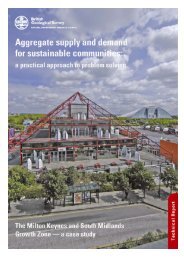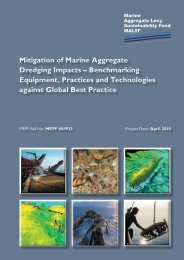creating environmental improvements through biodiversity
creating environmental improvements through biodiversity
creating environmental improvements through biodiversity
Create successful ePaper yourself
Turn your PDF publications into a flip-book with our unique Google optimized e-Paper software.
estoration of aggregate sites. Steering group.<br />
Output:<br />
Reviews literature in the public domain on invertebrate <strong>biodiversity</strong> and found little available. Highlighted one<br />
informative article written by Roger Key (2002)<br />
Points to www.goodquarry.com and www.mineralbap.com as the main relevant web resources, but states<br />
that they contain few mentions of invertebrates<br />
Describes key habitat features known to be beneficial to invertebrates<br />
Key findings:<br />
• That existing knowledge among stakeholders of invertebrate <strong>biodiversity</strong> on aggregate sites is limited,<br />
with 85% of those questioned having no specific understanding of how to restore and/or manage sites for<br />
their invertebrates<br />
• That 100% of respondents identified a need for production and dissemination of broad, sound site<br />
restoration and management principles, to highlight easy steps to realising the potential of aggregate sites for<br />
invertebrate <strong>biodiversity</strong><br />
• That there is no strategic overview of the role that individual aggregate sites can play in providing habitats<br />
for wildlife; and that habitat creation is currently delivered on a site-by-site basis<br />
• That few in the industry are aware of the potential cost effectiveness of restoring sites for invertebrates<br />
• That restoration practices promoted by the planning process are not currently benefiting – and are often<br />
proving detrimental to – invertebrate <strong>biodiversity</strong><br />
• That restoring sites for their invertebrate interest can provide communities with access to an important<br />
recreation and education resource<br />
• That public awareness of the role of aggregate habitats in supporting wildlife, and of the importance of<br />
invertebrate conservation, is low<br />
• That there are a number of perceived obstacles to altering agreed mineral restoration plans, even where<br />
these are likely to provide increased benefit to wildlife<br />
• That schemes often do not consider invertebrates at an early stage – or at all<br />
• That the planning process is focused on UK BAP priority habitats, and that these rarely cater for<br />
invertebrate populations that depend on extraction site micro-habitats<br />
• That existing projects on minerals and nature conservation need to be integrated to prevent duplication<br />
• That managing sites for geodiversity can benefit invertebrate populations<br />
Key Recommendations:<br />
• Knowledge and information needs to be collated, made available and widely disseminated in a best<br />
practice guide<br />
• Best practice should be presented in an easy-to-use and comprehensible format, and<br />
should focus on broad, sound principles for delivering invertebrate <strong>biodiversity</strong><br />
• This should be supported by more detailed information on key species, habitats and restoration<br />
techniques on the project website<br />
• There is a need for case studies that demonstrate good practice in managing and restoring habitats for<br />
invertebrates<br />
• Likely cost benefits of restoring sites for invertebrates need to be more firmly established<br />
• More invertebrate surveys need to be carried out on aggregate sites to improve the existing level of<br />
knowledge on key species and habitats<br />
• The project should work with industry to change public perceptions<br />
• A key message should be that invertebrate conservation is not only important for <strong>biodiversity</strong> and<br />
Sustainable Aggregates Creating Environmental Improvements <strong>through</strong> Biodiversity<br />
79

















